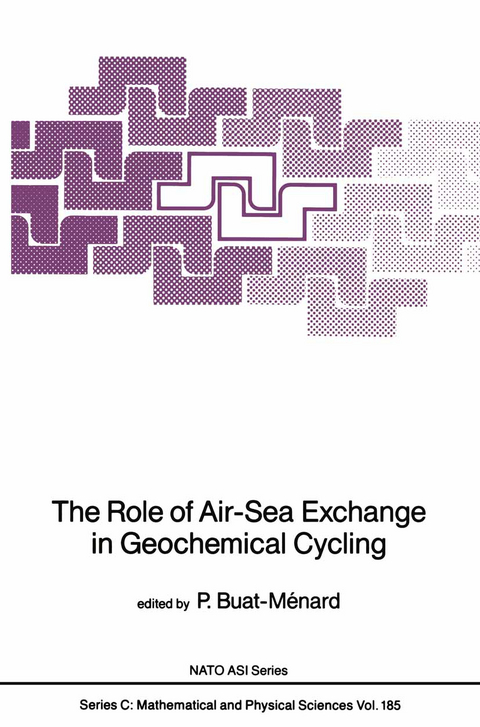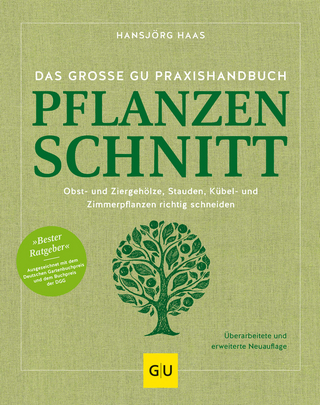
The Role of Air-Sea Exchange in Geochemical Cycling
Springer (Verlag)
978-94-010-8606-6 (ISBN)
Basic Concepts In Geochemical Modelling.- 1. Introduction.- 2.First Order Models.- 2.1. First order decay reaction.- 2.2. Instantaneous perturbation in a first order decay model.- 2.3. First order production model.- 3. Heterogeneous Catalysis and Enzymatic Type Reactions.- 4. Reversible Reactions.- 5. Model with Coupled Components in the Reservoir.- 6. Second Order Reactions.- 7. Periodic Fluctuations.- 8. Coupling of Reservoirs.- 9. Conclusions.- Atmospheric Pathways to the Oceans.- 1. Introduction.- 2. Atmospheric Structure and Transports.- 2.1. Boundary layer.- 2.2. Cloud scale transport.- 2.3. Storms and midlatitude circulation.- 2.4. Global scale exchange.- 3. Variability and Representativeness.- 3.1. Seasonal and interannual variability.- 3.2. Representativeness of observations.- 4. Modeling of Atmospheric Transport.- 4.1. Source identification models.- 4.2. Mechanistic models.- 4.3. Tropospheric chemistry system models.- Modeling Oceanic Transport of Dissolved Constituents.- 1. Introduction.- 2. Box Models.- 3. Advection-Diffusion Models.- 4. Equations of Motion.- 5. Conclusion.- Vertical Transport of Particles within the Ocean.- 1. Introduction.- 2. Determination of the Lognormal Coefficients L, ? and of N.- 2.1. Particle size data collection.- 2.2. Calculation of the coefficients L, ? and N from data.- 3. Determination of Suspended Particulate Matter Physical Properties using Lognormal coefficients.- 3.1. Surface area concentration.- 3.2. Mass concentration.- 3.3. Vertical fluxes.- 3.4. Residence time.- 3.5. Application to the open sea.- 4. Suspended Particulate Matter Sedimentation with Dissolution Process.- 4.1. Sedimentation at steady state.- 4.2. Sedimentation at non steady state.- 5. Conclusion.- 6. Appendix.- 6.1. Specific properties of the lognormallaw.- 6.2. Evaluation of the lognormal coefficients.- Air-Sea Gas Exchange Rates: Introduction and Synthesis.- 1. Introduction.- 2. Basic Principles.- 3. Models.- 3.1. Film model.- 3.2. Surface renewal models.- 3.3. Boundary-layer models.- 4. Laboratory (Wind Tunnel) Studies.- 4.1. Smooth surface regime.- 4.2. Rough surface regime.- 4.3. Breaking wave (bubble) regime.- 5. Field Measurements.- 5.1. Box method.- 5.2. Dissolved gas balance method.- 5.3. Micrometeorological techniques.- 5.4. Natural and bomb-produced 14C.- 5.5. The radon deficiency method.- 5.6. Sulphur hexafluoride.- 5.7. Summary.- 6. Synthesis.- 6.1. Comparison with field data.- The Ocean as a Source for Atmospheric Particles.- 1. Introduction.- 2. The ? ?E/?r Model.- 3. The ? ?2E/?t ?r Model.- 4. Comparison of ? ?E/?r and W ?2E/?t ?r Models.- 5. Oceanic Whitecap Coverage.- 6. Global Sea-to-Air Salt Flux.- 7. Toward a Comprehensive Marine Aerosol Generation Model.- The Ocean as a Sink for Atmospheric Particles.- 1. Overview.- 2. Assessement of Wet Deposition.- 3. Field Approach to Dry Deposition.- 4. Accurate Deposition Measurements do not Guarantee Accurate Net Air to Sea Transfer Rates.- 5. Relative Importance of Wet and Dry Removal Rates.- 6. Conclusion.- Atmospheric, Oceanic, and Interfacial Photochemistry as Factors Influencing Air-Sea Exchange Fluxes and Processes.- 1. Introduction.- 2. Environmental Photochemistry.- 2.1. Stratospheric photochemistry.- 2.2. Homogeneous tropospheric photochemistry.- 2.3. Heterogeneous tropospheric photochemistry.- 2.4. Seawater photochemistry.- 2.5. Soil photochemistry.- 3. Interaction of Photochemistry with Air-Sea Exchange Processes.- 3.1. Air-sea gas exchange.- 3.2. Rainout-washout deposition processes.- 3.3. Dry deposition.- 3.4. Marineaerosol generation.- 4. Summary.- Carbon Dioxide: Its Natural Cycle and Anthropogenic Perturbation.- 1. Introduction.- 2. The Natural Cycle of Carbon Dioxide.- 2.1. Reservoirs, fluxes, residence times.- 2.2. Air-sea exchange of CO2.- 2.3. Regional variability of air-sea fluxes.- 2.4. Marine carbonate chemistry.- 2.5. The oceanic carbon cycle.- 2.6. The cycle of oxygen.- 3. Anthropogenic Increase of Atmospheric CO2.- 3.1. Observations and airborne fraction.- 3.2. Modelling the oceanic response to carbon cycle perturbations.- 3.3. CO2 release from the terrestrial biosphere and the “missing CO2 sink”.- 3.4. Scenarios for future CO2 concentrations.- 3.5. Carbone isotope perturbations.- 4. Climatic Effects of CO2 Increase.- 5. Natural CO2 Variations.- 5.1. Seasonal variations.- 5.2. Correlation with El Ni?o.- 5.3. Glacial/interglacial changes.- CO2 Air-Sea Exchange during Glacial Times: Importance of Deep Sea Circulation Changes.- 1. Introduction.- 2. Evidence from Polar Ice Cores.- 2.1. Data.- 2.2. Discussion: is the ocean able to absorb the missing CO2?.- 3. Evidence from Deep Sea Sediments.- 3.1. Data.- 3.2. Various hypotheses explaining the sedimentary record.- 3.3. Cadmium as a proxy-indicator for past phosphate.- 4. Broecker’s two box Model for the CO2 Cycle.- 5. Evidence for Deep Water Circulation during the Last Climatic Cycle.- 5.1. Geochemical basis.- 5.2. Glacial to interglacial contrasts.- 5.3. Disappearance of North Atlantic Deep Water during the glacial to interglacial transition.- 5.4. Enhanced North Atlantic Deep Wafer formation during the inception of the glaciation.- 6. Conclusion.- Exchange of CO and H2 between Ocean And Atmosphere.- 1. Introduction.- 2. Determination of the Supersaturation Factors of CO and H2.- 3. Spatial and Temporal Changes ofdissolved CO and H2.- 4. Processes Sustaining CO and H2 Concentrations in Surface Water.- 4.1. Production processes.- 4.2. Consumption processes.- 4.3. Transport processes.- 5. Calculation of Fluxes by the “Laminar Film Model”.- 6. Role of Oceans in the budget of atmospheric CO and H2.- The Air-Sea Exchange of Low Molecular Weight Halocarbon Gases.- 1. Introduction.- 2. Gases for which the Oceans are a net Source for the Atmosphere.- 2.1. Alkyl (mainly Methyl) halides.- 2.2. Haloforms.- 2.3. Other organo-halides.- 3. Gases for which the Oceans are a net Sink for the Atmosphere.- 4. Summary.- Sea-Air Exchange of High-Molecular Weight Synthetic Organic Compounds.- 1. Introduction.- 2. Compounds of Interest.- 3. Sampling/Analytical Aspects of Trace Organics.- 4. Distribution of High Molecular Weight Organics in the Marine Environment.- 4.1. Water and organisms.- 4.2. Atmospheric concentrations.- 4.3. Atmospheric deposition.- 5. Air-Sea Exchange Mechanisms for Synthetic Organics.- 5.1. Dry deposition.- 5.2. Wet deposition.- 5.3. Adsorption and partitioning in surface waters.- 6. Air-Sea Fluxes in the North Pacific.- 7. Relative Importance of Atmospheric Deposition to the CHC Cycle.- 8. Summary and Conclusions.- The Ocean as a Source of Atmospheric Sulfur Compounds.- 1. Sources of Sulfur to the Atmosphere: an Overview.- 2. Seaspray and the Production of Aerosol Sulfate.- 3. Sulfate Reduction by Geological and Biological Processes.- 4. Assimilatory Sulfate Reduction.- 5. Biosynthesis of Dimethylsulfide.- 6. Marine Chemistry and Distribution of Dimethylsulfide.- 7. Estimating the Air/Sea Flux of Dimethylsulfide.- 8. Chemical Reactions and Transformations of Dimethylsulfide in the Marine Atmosphere.- 9. A Model of the Cycle of Biogenic Sulfur over the Oceans.- 10. CarbonylSulfide.- 10.1. Photochemical production of COS.- 10.2. Air/Sea exchange of COS.- 11. Formation and Emission of other Sulfur Species: Hydrogen Sulfide, Carbon Disulfide, Methylmercaptan, Dimethyldisulfide etc….- 11.1. Hydrogen sulfide.- 11.2. Carbon disulfide.- 11.3. Methylmercaptan, dimethyldisulfide and other sulfur compounds.- 12. Conclusion.- Cycling of Mercury Between the Atmosphere and Oceans.- 1. Introduction.- 2. Global Models.- 3. Physico-Chemical Models.- 4. Atmospheric Hg Determinations.- 4.1. Total gaseous Hg.- 4.2. Volatile Hg species.- 5. Hg Analysis in Seawater and Rainwater.- 5.1. Reactive and Total Hg.- 5.2. Volatile Hg.- 5.3. Determinations of Hg in rain.- 6. Air-Sea Exchange of Hg.- 6.1. Preliminary studies.- 6.2. Present status.- 6.3. Summary.- 7. Ocean Sources of Hg.- 7.1. Hg evasion from the Equatorial Pacific Ocean: 1980.- 7.2. Hg evasion from the Equatorial Pacific Ocean: 1984.- 8. Hg Deposition to the Sea Surface.- 8.1. Precipitation.- 8.2. Dry depositional Hg flux to the Equatorial Pacific Ocean.- 8.3. Air-sea exchange in the Equatorial Pacific Ocean.- 8.4. Physico-chemical aspects.- 9. Atmospheric Cycling of Hg over the Oceans: Global Perspectives.- The Air-Sea Exchange of Particulate Organic Matter: The Sources and Long-Range Transport of Lipids in Aerosols.- 1. Introduction.- 1.1. Background.- 2. Sampling and Analytical Methodology.- 3. Source and Long-Range Transport Studies.- 3.1. Introduction.- 3.2. North Pacific Trades: Enewetak.- 3.3. South Pacific Westerlies: New Zealand.- 3.4. Short-Range transport: Coastal Peru.- 4. Conclusions.- The Marine Mineral Aerosol.- 1. Introduction.- 2. The Concept of the Marine Dust Veil.- 3. Sources of Material to the Marine Atmosphere.- 4. The Distribution of Material in the Marine Dust Veil.- 4.1.Introduction.- 4.2. The Atlantic Ocean and surrounding waters.- 4.3. The Mediterranean.- 4.4. The Pacific ocean.- 4.5. The Indian ocean.- 4.6. Summary.- 5. The Composition of Material in the Marine Dust Veil.- 5.1. Introduction.- 5.2. The mineral composition of the marine dust veil.- 5.3. Chemical chacacteristics of the mineral aerosol.- 6. The Influence of the Marine Dust Veil on Oceanic Cycles.- 6.1. The water column.- 6.2. The sediment column.- 6.3. Summary.- Air to Sea Transfer of Anthropogenic Trace Metals.- 1. Introduction.- 2. The Fate of Atmospheric Trace Metals in Ocean Waters.- 2.1. Physical and chemical forms of metals in the atmosphere.- 2.2. Biogeochemical cycling of trace metals in the ocean.- 3. Geographical Variability of Metal Fluxes from the Atmosphere to the Ocean.- 4. Effects of Eolian Inputs of Anthropogenic Origin on the Distribution of Trace Metals in Surface and Deep Marine Waters.- 5. Conclusions.- The Impact of Atmospheric Nitrogen, Phosphorus, and Iron Species on Marine Biological Productivity.- 1. Introduction.- 1.1. Atmospheric deposition: geochemical and biological impact.- 1.2. Nutrients and primary productivity.- 1.3. A simple model of vertical transport to the photic zone.- 2. Nitrate and other Nitrogen Species.- 2.1. Calculations of nitrogen fluxes in open ocean regions.- 2.2. Atmospheric nitrogen input to coastal waters.- 3. Phosphorus.- 3.1. Atmospheric phosphorus and the phosphorus cycle.- 3.2. Calculations of phosphorus fluxes in open ocean regions.- 4. Iron.- 4.1. Introduction.- 4.2. Solubility of atmospheric iron.- 4.3. Calculations of iron fluxes in open ocean regions.- 5. General Discussion and Conclusions.- List of Participants.
| Reihe/Serie | NATO Science Series C ; 185 |
|---|---|
| Zusatzinfo | 568 p. |
| Verlagsort | Dordrecht |
| Sprache | englisch |
| Maße | 155 x 235 mm |
| Themenwelt | Sachbuch/Ratgeber ► Natur / Technik ► Garten |
| Naturwissenschaften ► Geowissenschaften ► Geologie | |
| Naturwissenschaften ► Geowissenschaften ► Hydrologie / Ozeanografie | |
| Naturwissenschaften ► Geowissenschaften ► Meteorologie / Klimatologie | |
| ISBN-10 | 94-010-8606-0 / 9401086060 |
| ISBN-13 | 978-94-010-8606-6 / 9789401086066 |
| Zustand | Neuware |
| Haben Sie eine Frage zum Produkt? |
aus dem Bereich


